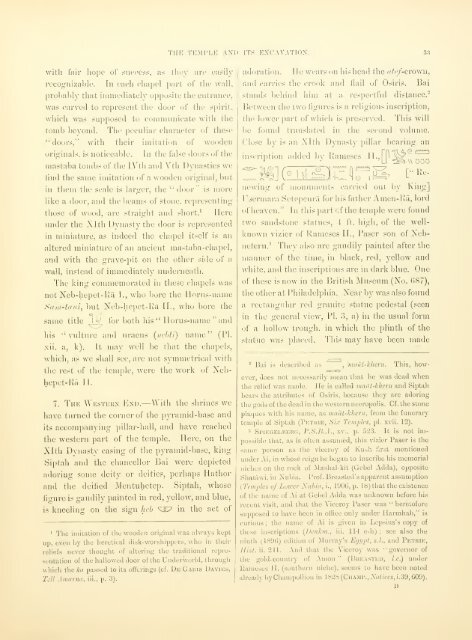The XIth dynasty temple at Deir el-Bahari .. - NYU | Digital Library ...
The XIth dynasty temple at Deir el-Bahari .. - NYU | Digital Library ...
The XIth dynasty temple at Deir el-Bahari .. - NYU | Digital Library ...
You also want an ePaper? Increase the reach of your titles
YUMPU automatically turns print PDFs into web optimized ePapers that Google loves.
with fair hope of success, as they are easily<br />
reco;;-nizable. In each chap<strong>el</strong> part of the wall,<br />
prol)aI)ly th<strong>at</strong> iiinncdi<strong>at</strong><strong>el</strong>y opposite the entrance,<br />
was carved to represent the door of the spirit,<br />
which was supposed to communic<strong>at</strong>e with the<br />
tomb beyond. <strong>The</strong> peculiar character of these<br />
"^ doors," with their imit<strong>at</strong>ion of wooden<br />
ori^xinals, is noticeable. In the false doors of the<br />
mastaba tombs of the IVtli and Vth Dynasties we<br />
find the same imit<strong>at</strong>ion of a wooden original, but<br />
in them the scalr is laruer, the "door" is more<br />
like a door, and tlic beams of stone, representing<br />
those of Avood, arc straight and short.' Here<br />
under the Xlth Dynasty the door is represented<br />
in mini<strong>at</strong>ure, as indeed the chap<strong>el</strong> its<strong>el</strong>f is an<br />
altered mini<strong>at</strong>ure of an ancient mastaba-chap<strong>el</strong>,<br />
and wirh the grave-pit on the other side of a<br />
wall, instead ol' iiiunedi<strong>at</strong><strong>el</strong>y underne<strong>at</strong>li.<br />
<strong>The</strong> king commemor<strong>at</strong>ed in these chap<strong>el</strong>s uus<br />
not Neb-hepet-lla 1., who bore the Horus-name<br />
Sdiii-iani, but Ncb-liopet-lia II., who l)ore the<br />
same title I<br />
-V fur both his " llurus-namu "<br />
THE TEMPLE AND ITS EXCAVATION. 33<br />
and<br />
his "vulture and uraeus (luhti) name" (PI.<br />
xii. a, k). It may w<strong>el</strong>l be th<strong>at</strong> the chap<strong>el</strong>s,<br />
which, as we shall see, are not symmetrical with<br />
the rest of the <strong>temple</strong>, wei'c the work of Neb-<br />
hepet-Ru II.<br />
7. 'rni; Western End.—With the shrines we<br />
have turned the corner of the pyramid-base and<br />
its accompanying pillar-hall, and have reached<br />
the western part of the <strong>temple</strong>. Here, on the<br />
Xlth Dynasty casing of the pyramid-base, king<br />
Siptah and the chanc<strong>el</strong>lor Bai were depicted<br />
adoring sonic deity or deities, perhaps Il<strong>at</strong>lior<br />
and the deified Mentuhetep. Siptah, whose<br />
figure is gaudily painted in red, y<strong>el</strong>low, and blue,<br />
is kne<strong>el</strong>ing on the sign lieb "^5^ in the act of<br />
' <strong>The</strong> imit<strong>at</strong>ion of the wooden original was always kept<br />
up, even by the heretical disk-worshippers, who in their<br />
r<strong>el</strong>iefs never thought of altering the traditional repre-<br />
sent<strong>at</strong>ion of the hallowed door of the Underworld, through<br />
which the Jta passed to its offerings (of. De G.uus Davies,<br />
TM Amarna, iii., p. 3).<br />
ador<strong>at</strong>ion. He wears on his head the (//(;^-crown,<br />
and carries the crook and flail of Osiris. Bai<br />
stands behind him <strong>at</strong> a respectful distance.'<br />
Between the two figures is a r<strong>el</strong>igious inscription,<br />
the lower part of which is preserved. This will<br />
be found transl<strong>at</strong>ed in the second volume.<br />
Close by is an Xlth Dynasty pillar bearing an<br />
inscription added by Ilameses II., 'J^<br />
newing of monuments earned out by King]<br />
Usermara Setepenra for his f<strong>at</strong>her Amen-Ra, lord<br />
of heaven." In this part of the <strong>temple</strong> were found<br />
two sandstone st<strong>at</strong>ues, i ft. high, of the w<strong>el</strong>lknown<br />
vizier of Rameses II., Raser son of Neb-<br />
neteru.^ <strong>The</strong>y also are gaudily painted after the<br />
manner of the time, in black, red, y<strong>el</strong>low and<br />
white, and the inscriptions are in dark blue. One<br />
of these is now in the British Museum (No. 687),<br />
the other <strong>at</strong> Philad<strong>el</strong>phia. Near by was also found<br />
a rectangular red granite st<strong>at</strong>ue pedestal (seen<br />
in the general view, PI. .3, a) in the usual form<br />
of a hollow trough, in which the plinth of the<br />
st<strong>at</strong>ue was placed. This may have been made<br />
'^ Bai is described as , madt-khcru. This, how-<br />
ever, does not necessarily mean th<strong>at</strong> he was dead when<br />
the r<strong>el</strong>ief was made. He is called vmCit-kheru and Siptah<br />
bears the <strong>at</strong>tributes of Osiris, because they are adoring<br />
the gods of the dead in the western necropolis. Cf . the stone<br />
plaques with his name, as via<strong>at</strong>-kheru, from the funerary<br />
<strong>temple</strong> of Siptah (Petuie, Six TcmiAcs, pi. xvii. 12).<br />
> Spieg<strong>el</strong>berg, r.S.IJ.A., xv., p. 523. It is not im-<br />
possible th<strong>at</strong>, as is often assumed, this vizier Paser is the<br />
same person as the viceroy of Kubh first mentioned<br />
under Ai, in whose reign he began to inscribe his memorial<br />
niches on the rock of Mashal-kit (Geb<strong>el</strong> Adda), opposite<br />
Sh<strong>at</strong>awi, in Nubia. Prof. Breasted's apparent assumption<br />
[Temples of Lower Nubia, i., I'JOG, p. 18) th<strong>at</strong> the existence<br />
of the name of Ai <strong>at</strong> G<strong>el</strong>)<strong>el</strong> Adda was unknown before his<br />
recent visit, and th<strong>at</strong> the Viceroy Paser was " heretofore<br />
supposed to have been in oflice only under Harmhab," is<br />
curious ; the name of Ai is given in Lepsius's copy of<br />
these inscriptions (Dcnkm., iii. 114 e-h) ; see also the<br />
ninth (1896) edition of Murray's Egypt, s.L, and Petrie,<br />
Ilist.ii. 2-11. And th<strong>at</strong> the Viceroy was "governor of<br />
the gold-country of Anion " (Bkic.vsted, I.e.) under<br />
Eameses II. (southern niche), seems to have been noted<br />
already by ChampoUiou in 1828 (Cii.\mi'., Notices, i.39, 009)<br />
D<br />
.

















